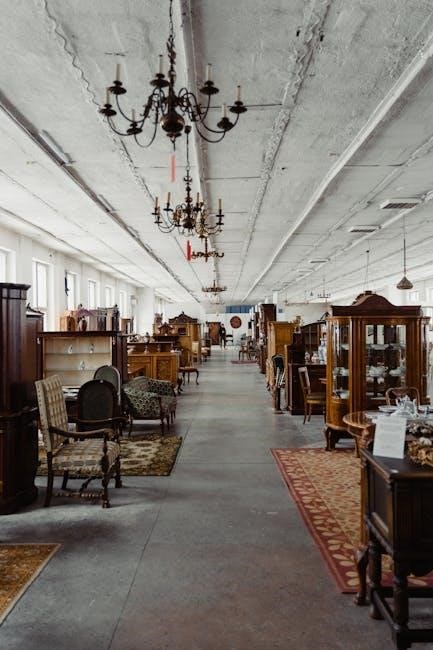Learning vintage antique chair identification helps collectors
find rare
pieces, with online guides and experts providing valuable insights and knowledge on various chair styles and designs, making the process easier and more accessible always.
Understanding the Basics of Antique Chair Identification
To understand the basics of antique chair identification, it is essential to have a general knowledge of furniture history and design. This includes being familiar with different styles, such as Victorian, Edwardian, and Art Deco, as well as various types of chairs, like armchairs, side chairs, and rocking chairs. Online resources, such as eBay and antique websites, can provide valuable information on antique chair identification, including guides, tutorials, and expert advice. Additionally, consulting with experts, such as antique dealers and appraisers, can help individuals gain a deeper understanding of antique chair identification. By learning the basics, collectors and enthusiasts can develop the skills necessary to identify and appreciate antique chairs. With practice and experience, anyone can become proficient in identifying antique chairs and distinguishing them from vintage or replica pieces, making it easier to find rare and valuable items. Antique chair identification requires patience, dedication, and a willingness to learn.

History of Antique Chairs
Antique chairs originated from ancient civilizations, with
evolving
designs and styles, influencing modern furniture, and shaping the industry, with various cultural and historical factors always playing a significant role somehow.
Early Antique Chairs from the 1600s and 1700s
During the 1600s and 1700s, antique chairs were primarily made from oak and walnut woods, with simple designs and minimal ornamentation, reflecting the functional and practical needs of the time. The chairs from this period were often heavy and sturdy, with thick legs and seats, and were typically used for everyday purposes. As the centuries progressed, chair designs began to evolve, with the introduction of new materials and techniques, such as upholstery and carving. The early antique chairs from this period are highly sought after by collectors and historians, who value their historical significance and cultural importance. These chairs provide a unique glimpse into the past, offering insights into the lives and lifestyles of people from previous centuries; By studying these early antique chairs, we can gain a deeper understanding of the social, economic, and cultural contexts in which they were created, and appreciate the craftsmanship and skill that went into their production.
Antique Chair Designs through History
Antique chair designs have undergone significant transformations throughout history, reflecting the artistic, cultural, and social trends of their time. The evolution of chair design is a fascinating story, with various styles and periods emerging in response to changing lifestyles, technological advancements, and aesthetic preferences; From the ornate and elaborate designs of the Baroque period to the sleek and minimalist lines of the Modern era, antique chairs have played a vital role in shaping the course of furniture history. The development of new materials and manufacturing techniques has also influenced chair design, enabling craftsmen to create more intricate and complex pieces. By examining the diverse range of antique chair designs, we can gain a deeper understanding of the historical context in which they were created and appreciate the ingenuity and craftsmanship that went into their production. This knowledge is essential for identifying and appreciating the beauty and significance of antique chairs.

Types of Antique Chairs
Antique chairs include various styles, such as armchairs, side chairs, and lounge chairs, each with unique characteristics and historical significance, making them valuable collectibles and highly sought after by collectors always.
Definition of Antique and Vintage Chairs
To understand the difference between antique and vintage chairs, it is essential to define these terms. Antique chairs are typically defined as those that are over 100 years old, while vintage chairs are those that are between 40 and 100 years old. This distinction is crucial in determining the value and significance of a chair. The definition of antique and vintage chairs is not just about age, but also about the style, design, and historical context in which they were created. By understanding these definitions, collectors and enthusiasts can better appreciate the unique characteristics of each type of chair. The distinction between antique and vintage chairs is also important for authentication and valuation purposes. Online resources and expert guides can provide more information on the definition and distinction between antique and vintage chairs, helping collectors make informed decisions when purchasing or selling these items. Chair collectors and enthusiasts can benefit from this knowledge.
Distinguishing Between Antique and Vintage Chairs
Distinguishing between antique and vintage chairs requires a careful examination of the chair’s characteristics, including its materials, construction, and design. The age of the chair is a critical factor, with antique chairs typically being over 100 years old and vintage chairs being between 40 and 100 years old. The condition of the chair is also important, with antique chairs often showing signs of wear and tear, while vintage chairs may still be in relatively good condition. Online resources and expert guides can provide more information on how to distinguish between antique and vintage chairs, including tips on identifying period-specific features and materials. By understanding the differences between antique and vintage chairs, collectors and enthusiasts can make informed decisions when purchasing or selling these items. Chair collectors and enthusiasts can benefit from this knowledge, and it can help them to build a collection of rare and valuable chairs. The process of distinguishing between antique and vintage chairs can be complex, but it is a crucial step in identifying and valuing these items.

Methods for Identifying Antique Chairs
Experts use various
techniques
to identify antique chairs, including examining the chair’s construction, materials, and design, to determine its age and authenticity, and provide accurate identification always online.
Researching Design Periods and Chair Types
Researching design periods and chair types is a crucial step in identifying vintage antique chairs, as it helps collectors and enthusiasts understand the historical context and stylistic influences that shaped the design of the chair. By studying the different design periods, such as Victorian, Art Nouveau, and Art Deco, collectors can gain a deeper understanding of the chair’s origins and significance; Online resources, such as museums and antique dealer websites, provide a wealth of information on various chair types, including armchairs, side chairs, and rocking chairs. Additionally, consulting with experts and joining online forums can help collectors connect with other enthusiasts and gain valuable insights into the world of vintage antique chair identification. With this knowledge, collectors can make informed decisions when purchasing or selling vintage antique chairs, and appreciate the beauty and craftsmanship of these unique pieces of furniture. This research also helps to identify rare and valuable chairs.
Examining Chair Construction and Materials
Examining the construction and materials of a vintage antique chair is essential to determine its authenticity and value. Collectors should inspect the chair’s frame, joints, and hardware to identify the type of wood, metal, or other materials used. The quality of craftsmanship, such as the precision of the joints and the smoothness of the finish, can also indicate the chair’s age and origin. Online resources, such as antique furniture restoration websites, can provide guidance on identifying different types of wood and materials. Additionally, consulting with experts, such as furniture restorers, can help collectors gain a deeper understanding of the chair’s construction and materials. By examining the chair’s construction and materials, collectors can gather valuable information about the chair’s history and significance, and make informed decisions when purchasing or selling vintage antique chairs. This examination also helps to detect any repairs or alterations that may affect the chair’s value.

Expert Guidance on Antique Chair Identification
Consulting with experts and using online resources provides valuable guidance and insights for identifying antique chairs and determining their authenticity and value always with accurate information and expertise.
Consulting with Experts and Using Online Resources
Consulting with experts and using online resources is a crucial step in identifying antique chairs, as it provides access to a wealth of knowledge and information. Many experts specialize in antique furniture and can offer valuable guidance on identifying and dating chairs. Online resources, such as websites and forums, can also provide a wealth of information on antique chairs, including photos, descriptions, and pricing guides. Additionally, online marketplaces and auction sites can be a great resource for researching and identifying antique chairs. By consulting with experts and using online resources, collectors and enthusiasts can gain a better understanding of antique chairs and make more informed purchasing decisions. Furthermore, online resources can also provide information on chair restoration and conservation, which is essential for maintaining the integrity and value of antique chairs. Overall, consulting with experts and using online resources is an essential part of the antique chair identification process.
